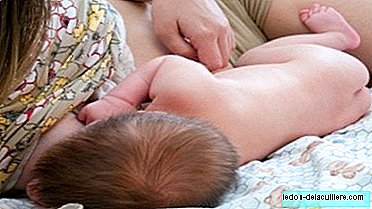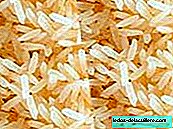
During pregnancy, the breasts are one of the parts of the woman's body that changes the most, to be able to feed the newborn after delivery.
In fact, its transformation is usually one of the first signs of pregnancy. Its appearance will not be the same before pregnancy as during pregnancy, but they will also vary when breastfeeding begins and, again, at the time of weaning. Why these changes?
Although it is at puberty when the breasts begin to develop, after that stage they are not yet mature organs and are constantly changing until menopause. This is explained by Medela, who speaks of these transformations.
Before pregnancy
In addition to the usual changes in age, the breasts renew their own internal cells as part of the menstrual cycle, which is why women can feel them soft and sensitive or experience swelling during the period.
Pregnancy

With pregnancy, the cycle of renewal of the internal breast cells is interrupted: the mother's progesterone levels begin to decrease, beginning the transformation of the breasts into milk producing organs.
The galactophores ducts (the internal ducts of the breast that are responsible for carrying milk from the breast lobes to the nipple) increase in number and complexity, and begin to fork to form a complex feeding system for the baby.
In turn, the lactocytes (the milk-producing cells) also begin to develop inside the breasts and double the amount of blood that reaches them. For that reason, veins can even be seen through the skin.
Further, The woman is likely to end her pregnancy with a size and a half or two more breast. For that reason, it is recommended that you wear a pregnancy or breastfeeding bra, approximately at 12 weeks gestation. They are seamless models, with wide straps and with a soft and breathable fabric.
You should keep in mind when buying it, which is also likely to increase because the rib cage expands to make room for the baby.
First trimester
Often, the changes that breasts experience are the first sign of pregnancy in many women.
After three or four weeks, the increase in hormones and the transformation in the structure of the breasts make both breasts and nipples very sensitive and softer.
In most cases, this pain subsides after exceeding the first trimester, but in some women the pain may persist until delivery.
Second trimester
It is possible that the nipples and areolas (the skin circles surrounding the nipples) increase in size, since milk producing cells are activated on week 15 of gestation, and at week 22 production will begin.
But pregnancy hormones prevent accumulation or loss of milk, so the body reabsorbs it.
Another noticeable change is noted in the Montgomery tubers (the small bumps or granites of the areola). They get bigger and darker, secreting a moisturizing oil that protects against pain and infections when breastfeeding starts.
 Offered by ChiccoOcho common problems in breastfeeding and how to solve them
Offered by ChiccoOcho common problems in breastfeeding and how to solve themThird trimester
Breast milk is ready in the breasts before the baby is born. Therefore, it is likely that during the last weeks of pregnancy the nipples begin to secrete some colostrum (first milk).
 In Babies and more The composition of breast milk at each stage of growth: this adapts to the needs of the baby
In Babies and more The composition of breast milk at each stage of growth: this adapts to the needs of the baby To prevent moisture stains from piercing clothes, future mothers can place absorbent discs inside the bra.
An advice: If the woman has flat or inverted nipples, it is advisable to place a nipple shaper inside the bra to help remove the nipples, from the 32 week week of gestation. This will make it easier for the newborn to get a good grip on the chest.
During these last months it is likely to feel heavier or sore breasts. This sensation can be improved with the use of a sleeping bra and a sports bra as a reinforcement to exercise and avoid pain in the breasts and ligaments.
Lactation

Between the second and the fourth day after delivery it is normal for the breasts to be fuller and firmer because the call occurs 'rise of milk'. It can happen later if there has been a C-section or a traumatic birth.
Some mothers feel discomfort or pain in the breasts after the birth of the baby. This problem, called 'congestion'It occurs when the mother produces more milk than the breasts can withstand, causing them to harden excessively and be extremely full.
 In Babies and more 11 positions to breastfeed and achieve successful breastfeeding, what is yours?
In Babies and more 11 positions to breastfeed and achieve successful breastfeeding, what is yours?It is a temporary situation and it is necessary to continue breastfeeding the newborn.
So that the breasts do not suffer, it is important:
Make sure the baby has a good grip.
Breastfeed at least eight times a day and in different positions.
Massage the breasts during the shot to achieve maximum emptying or pumping until you feel comfortable.
 In Babies and more, sore nipples? Seven tips for painless breastfeeding
In Babies and more, sore nipples? Seven tips for painless breastfeedingFurther, During the first three months of breastfeeding, it is likely to continue to notice the breasts quite full before a shot. As the baby grows, the mother will notice that her breasts are not so full. But that doesn't mean they produce less milk.
After six months, it is normal to lose chest fat, so that its size will tend to reduce progressively. This change will occur even if the mother no longer breastfeeds the baby, and it is because the breasts work more efficiently, possibly caused by a redistribution of breast tissue.
After weaning
The moment the baby stops breastfeeding, regardless of when it happens, the breast will return to its inactive state, reversing the entire breastfeeding process.
 In Babies and more The natural age of weaning: how long to breastfeed the baby?
In Babies and more The natural age of weaning: how long to breastfeed the baby?The usual after weaning is that within three months the breasts will recover the size prior to pregnancy.
Photos | iStock












